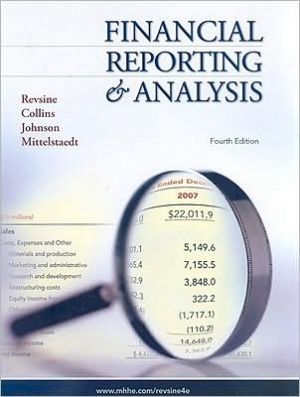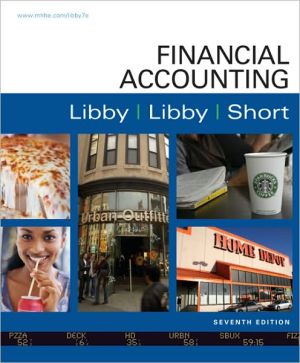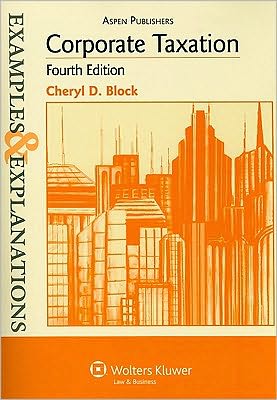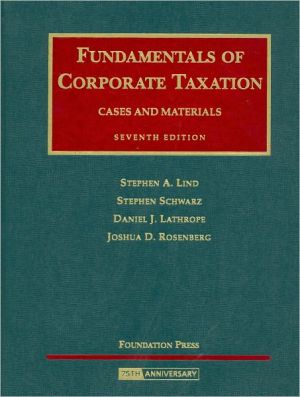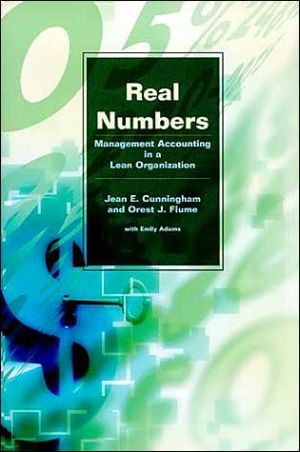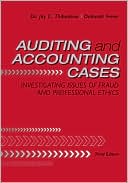Financial Reporting and Analysis
Financial Reporting and Analysis, Second Edition reveals the truths hidden behind the numbers and shows the pitfalls to avoid when analyzing financial statements. A focus on core topics allows readers to examine the economic and institutional setting for financial reporting, accrual accounting and income determination, structure of the balance sheet and statement of cash flows, essentials of financial statement analysis, the role of financial information in valuation and contracting,...
Search in google:
Suitable for a second-level course in financial accounting, this textbook focuses on the details of the economics behind the transactions or the role of accounting in the decision-making process rather than on the details of GAAP. Specific chapters discuss the economic and institutional setting for financial reporting, accrual accounting and income determination, balance sheet structures, financial statement analysis, cash flow analysis and credit risk assessment, receivables, inventories, long-lived assets and depreciation, liabilities, leases, income tax reporting, pensions, intercorporate equity investments, and international finance reporting. The authors teach accounting at Northwestern University and the University of Iowa. Annotation c. Book News, Inc., Portland, OR (booknews.com)
Preface \ Consistent with the mandates of the Accounting Education Change Commission (AECC), our objective in writing Financial Reporting & Analysis, Second Edition, is to change the way the second-level course in financial accounting is taught, both to) graduate and undergraduate students. Typically this course—often called Intermediate Accounting—focuses on the details of GAAP with little emphasis on understanding the economics of transactions or how statement readers use the resultant numbers for decision making. Traditional intermediate texts are encyclopedic in nature and approach, emphasizing the accounting process and the myriad of arcane accounting rules and procedures that comprise GAAP.\ In contrast, the goal of our book is to develop a "critical thinking" approach to financial) accounting and reporting. We seek to develop students' understanding of the environment: in which financial reporting choices are made, what the options are, how these data are used for various types of decisions, and—most importantly—how to avoid misusing financial statement data. We convey the exciting nature of financial reporting in two stages. First, we provide a framework for understanding management's accounting choices and how the accounting affects reported financial numbers. Business contracts-like debt covenant agreements and management compensation agreements-are usually linked to accounting, numbers. We show how this often creates incentives for managers to exploit the flexibility in GAAP to "manage" reported accounting numbers to benefit themselves as well as shareholders. Second, we use real-world financial reports and events to illustrate vividlyhow GAAP alternatives and subjective accounting estimates give managers discretion in the timing of earnings and in reporting the components of financial position.\ The approach adopted in this book integrates the perspectives of accounting, corporate finance, economics, and critical analysis to help students grasp how business transactions get reported and understand their decision implications. In this approach, we cover all of the core topics of intermediate accounting by first describing the business transactions that affect various accounts, the technical details of GAAP, how these rules are applied in practice, and what the financial statements look like. Then we go a step further and ask: What do the numbers mean? Does the accounting process yield numbers that accurately reflect the underlying economic situation of a company? And, if not, what can statement users do to overcome this limitation in order to make more informed decisions?\ Our book is aimed not only at those charged with the responsibility for preparing financial statements, but also at those who will use financial statements for making decisions. Our definition of "users" is broad and includes lenders, equity analysts, investment bankers, boards of directors, and others charged with monitoring corporate performance and the behavior of management. As such, it includes auditors who establish audit scope and conduct analytical review procedures to spot problem areas in external financial statements. Statement of Auditing Procedures (SAS) 82, "Consideration of Fraud in a Financial Statement Audit," stresses that auditors must act as "financial detectives" to uncover financial reporting irregularities. To do this effectively requires an understanding of the incentives of managers, how the flexibility of GAAP can sometimes be exploited to conceal rather than reveal financial truth, and the potential danger signals that should be investigated. Our intent is to help readers learn how to conduct better audits, improve cash flow forecasts, undertake realistic valuations, conduct better comparative analyses and make more informed judgments about the performance of management.\ Financial Reporting & Analysis, Second Edition, provides instructors with the teaching/learning approach for achieving many of the goals stressed by the Accounting Education Change Commission. Specifically, our book is designed to instill capacities for: 1) thinking in an abstract, logical manner, 2) solving unstructured problems, 3) understanding the determining forces behind management's accounting choices, and 4) encouraging an integrated, cross-disciplinary view of financial reporting. Text discussions were written, and exercises, problems, and cases were carefully chosen to help achieve these objectives. But the book achieves these AECC goals without sacrificing technical underpinnings. Throughout, we explain in detail where the numbers come from, what measurement rules are used, and how they are entered into the accounting records. We have strived to provide a comprehensive user-oriented focus while simultaneously helping students build a strong technical foundation.\ Key Changes from the First Edition\ The first edition of our book has been widely adopted in accounting departments at business schools throughout the United States, Canada, Europe, and the Pacific Rim. It has been used successfully at both the graduate and undergraduate levels as well as in investment banking, commercial lending, and other corporate training programs. Many of our colleagues who used the first edition have provided us with valuable feedback. Based on their input, we have made a number of changes in this edition of the book to achieve the objectives outlined above more effectively. Key changes include the following:\ \ More international examples and discussion of International Accounting Standards (IAS) are interspersed throughout the book.\ Special "Getting Behind the Numbers" icons are used to highlight and link discussions in later chapters back to the analysis, valuation, and contracting framework set forth in Chapters 5, 6, and 7.\ The examples and exhibits from actual company reports have been updated and expanded to illustrate alternative accounting treatments and new disclosures stemming from recent FASB pronouncements.\ Problems and cases in all chapters have been updated and expanded to provide a larger number of straight-forward application problems as well as "stretch" analysis problems that are designed to test students' reasoning and analytical thinking skills.\ A new appendix to Chapter 2 reviews the accounting equation, debit-credit procedures, journal entries, the adjusting and closing process, statement preparation, and T-account analysis.\ A new Chapter 3, "Additional Topics in Income Determination," has been added that contains a discussion of specialized areas of revenue recognition as well as issues covered in SEC Staff Accounting Bulletin (SAB) 101 on "Revenue Recognition:" Prompted by recent concerns raised by former SEC Chairman Arthur Levitt, this chapter also provides an overview of techniques frequently used by firms to manage earnings.\ Chapter 4, "Structure of the Balance Sheet and Statement of Cash Flows," contains a new section on how financial statement "fingerprints" provide dues about unique industry characteristics (including dot.coms). The balance sheet of Cadbury Schweppes, plc, is used to illustrate international differences in statement format and account terminology.\ Chapter 5, "Essentials of Financial Statement Analysis," contains a new section on "Cash Earnings and EBITDA" Amazon.com is used as the focal point to illustrate the use—and misuse—of this earnings construct by Wall Street analysts.\ Chapter 6, "The Role of Financial Information in Valuation;' features a new section on valuing "dot.com" companies and additional end-of-chapter problem material on valuation.\ Chapter 8, "Receivables," contains an expanded discussion of securitizations and a new Self-Study problem on this topic.\ Chapter 9, "Inventories," contains a new section on inventory errors and an expanded discussion of how earnings can be managed through inventory (production) decisions.\ Chapter 10, "Long-Lived Assets and Depreciation;" has an expanded discussion of intangibles that explains how statement readers can overcome some of the limitations of GAAP reporting in this area. We have also expanded our discussion of capitalization of interest and how it affects interperiod analysis.\ Chapter 11, "Financial Instruments as Liabilities," has undergone extensive revision and now contains a thorough discussion of risk management, derivative securities, hedging transactions, and hedge accounting.\ Chapter 12, "Financial Reporting for Leases," contains an expanded discussion of leases with up-front payments and is one of the few texts that covers synthetic leases. The illustration of constructive capitalization of operating leases has been expanded and simplified.\ Chapter 13, "Income Tax Reporting," has been updated with new tax footnote disclosures from Merck. Tax footnote disclosures from Lubrizol and Cambrex are used to illustrate how adjustments can be made to reported earnings to compare firms that use different depreciation methods.\ Chapter 14, "Pensions and Postretirement Benefits," has been revised to illustrate real companies' SFAS No. 132 pension disclosure requirements and what they mean for informed analysis. We now include a discussion of the controversial "cash balance" pension plans.\ Chapter 15, "Financial Reporting for Owners' Equity," contains one of the most extensive discussions of employee stock option plans (ESOPs) and related accounting issues in any financial reporting text. We've also expanded our discussion of earnings per share calculations.\ Chapter 16, "Intercorporate Equity Investments," contains a discussion of the FASB's recently proposed changes for goodwill accounting and new criteria for determining control. Unlike most other texts, this chapter illustrates how purchase accounting for business combinations can distort year-to-year comparisons of sales and earnings growth.\ Chapter 17, "Statement of Cash Flows," contains an expanded discussion of why changes in working capital balance sheet accounts do not correspond to adjustments to accrual earnings to arrive at operating cash flows shown on the cash flow statement. It also contains a new "Analytical Insights" section that discusses "cash burn rates" and "time to burnout" measures for Internet stocks.\ Chapter 18, "Overview of International Financial Reporting Differences and Inflation," contains an expanded discussion of the International Accounting Standards Board's activities as well as the SEC's views on accepting IASB standards for Form 20-F filings.\
Chapter 1: The Economic and Institutional Setting for Financial ReportingChapter 2: Accural Accounting and Income DeterminationChapter 3: Additional Topics in Income DeterminationChapter 4: Structure of the Balance Sheet and Statement of Cash FlowsChapter 5: Essentials of Financial Statement AnalysisChapter 6: The Role of Financial Information in Valuation and Credit Risk AssessmentChapter 7: The Role of Financial Information in Contracting Chapter 8: ReceivablesChapter 9: InventoriesChapter 10: Long-Lived Assets and DepreciationChapter 11: Financial Instruments as LiabilitiesChapter 12: Financial Reporting for LeasesChapter 13: Income Tax ReportingChapter 14: Pensions and Postretirement BenefitsChapter 15: Financial Reporting for Owners’ EquityChapter 16: Intercorporate Equity InvestmentsChapter 17: Statement of Cash FlowsChapter 18: Overview of International Financial Reporting Differences and InflationAppendix I: Present Value TablesAppendix II: WWW/Electronic Resources for Financial InformationINDEX
